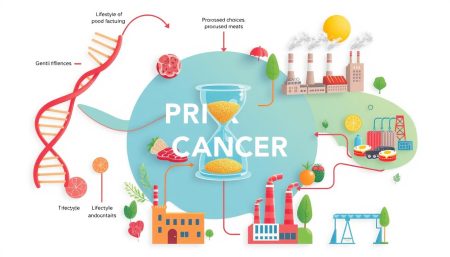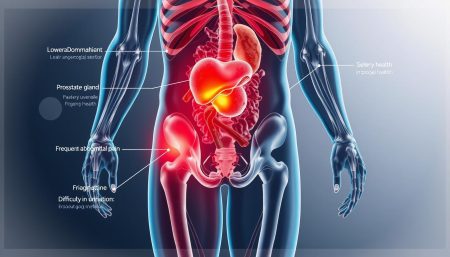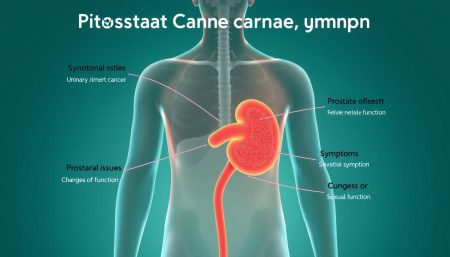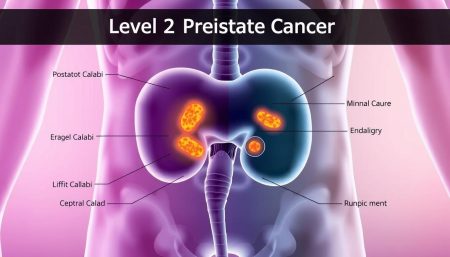Cancer treatment has seen big improvements, with immunotherapy being a key player. Car T cell therapy is a game-changer, using a patient’s immune cells to fight cancer. It’s a hopeful treatment for those with tough-to-treat cancers.
The process of making car T cell therapy is complex and needs top-notch facilities and skills. It involves taking a patient’s T cells, modifying them, and putting them back in the patient. Each step is critical for the therapy’s success.
In this guide, we’ll explore the car T cell therapy making process in detail. We’ll look at the main steps, the challenges, and what’s next in this promising field. Understanding how CAR T cells are made helps us see the huge promise of this immunotherapy and the hope it offers to cancer patients.
Introduction to CAR T Cell Therapy
CAR T cell therapy is a new way to fight cancer. It uses the body’s immune system to attack cancer cells. This method is changing how we treat cancer, making it more personal.
At the heart of CAR T cell therapy are special proteins called chimeric antigen receptors (CARs). These proteins are made to find and stick to cancer cells. This lets the immune system target and kill cancer cells more effectively.
To make CAR T cells, doctors first take a patient’s T cells. This is done through a process called leukapheresis. Then, these cells are changed in a lab to have the CARs. The modified T cells are then given back to the patient to find and destroy cancer cells.
“CAR T cell therapy represents a paradigm shift in cancer treatment, moving away from traditional chemotherapy and radiation towards a more targeted and personalized approach.” – Dr. Susan Smith, oncologist
CAR T cell therapy has shown great results in treating blood cancers. For example, it has helped patients with acute lymphoblastic leukemia (ALL) and diffuse large B-cell lymphoma (DLBCL). These patients have seen their cancer go into remission, even after other treatments failed.
| Cancer Type | Response Rate | Complete Remission Rate |
|---|---|---|
| ALL | 80-90% | 60-80% |
| DLBCL | 50-70% | 30-50% |
Research is now looking at using CAR T cell therapy for solid tumors and other cancers. Trials are underway to make this treatment even better. This could lead to more people being able to get personalized cancer treatments in the future.
Overview of the CAR T Cell Manufacturing Process
The making of CAR T cell therapies is a complex, highly regulated process. It involves many steps to ensure the product is safe, effective, and consistent. Knowing about these stages helps us understand the challenges and opportunities in this field.
Key Steps in CAR T Cell Production
The first step is collecting the patient’s T cells through leukapheresis. Then, these cells are activated. This is done using special beads or plates coated with antibodies.
After activation, the T cells are changed genetically. A viral vector carries the CAR gene into the cells. This lets the cells make the CAR on their surface. The cells are then grown in bioreactors to get enough for treatment.
Importance of Quality Control and Standardization
Quality control is key throughout the process. Tests check for cell health, sterility, and more. Standardizing protocols and materials helps keep product quality consistent.
As CAR T cell therapies become more common, making them cheaper and faster is vital. Using automation and off-the-shelf cells could help make them more accessible.
Leukapheresis: Harvesting Patient’s T Cells
The first step in making CAR T cell therapy is leukapheresis. This process collects a patient’s T cells. It makes sure the CAR T cells are made just for that patient, reducing the chance of bad reactions.
Leukapheresis draws blood from the patient. Then, a special machine separates and collects the T cells. The rest of the blood goes back to the patient.
The T cells are then sent to a lab for genetic changes and growth. This process usually takes a few hours. Sometimes, it needs to be done more than once.
How well the T cells are collected can depend on the patient’s health and age. The table below shows the main steps in leukapheresis:
| Step | Description |
|---|---|
| 1. Patient preparation | The patient gets checked and given medicine to help collect T cells better. |
| 2. Venous access | A special line is put in to take blood out and put it back in. |
| 3. Apheresis | Blood is drawn, processed to get white blood cells, and then returned. |
| 4. T cell collection | The white blood cells are processed to get more T cells, which are then sent to the lab. |
Getting good T cells through leukapheresis is key for CAR T cell therapy. As science moves forward, new ways to collect T cells will make this process better.
T Cell Activation and Genetic Modification
First, T cells are taken from a patient through leukapheresis. Then, the cells go through t cell activation and genetic modification. These steps help the T cells to find and attack cancer cells.
Methods of T Cell Activation
To get T cells ready for genetic changes, they need to be activated. There are a few ways to do this:
- Antibody-coated magnetic beads (e.g., anti-CD3/anti-CD28 beads)
- Artificial antigen-presenting cells (aAPCs)
- Soluble antibodies or recombinant proteins
The method chosen depends on how well it works, how easy it is to do, and if it meets rules. Antibody-coated beads are often used because they work well and are simple.
Viral Vector Transduction for CAR Gene Insertion
After being activated, T cells get the CAR gene. Viruses are used to carry the gene into the cells. There are two main types of viruses used:
| Viral Vector | Advantages | Disadvantages |
|---|---|---|
| Lentivirus | Stable integration, infects non-dividing cells | Potential for insertional mutagenesis |
| Retrovirus | High transduction efficiency, well-characterized | Requires actively dividing cells |
The CAR gene is put into the virus. Then, the virus adds the gene to the T cells. This lets the T cells find and attack cancer cells.
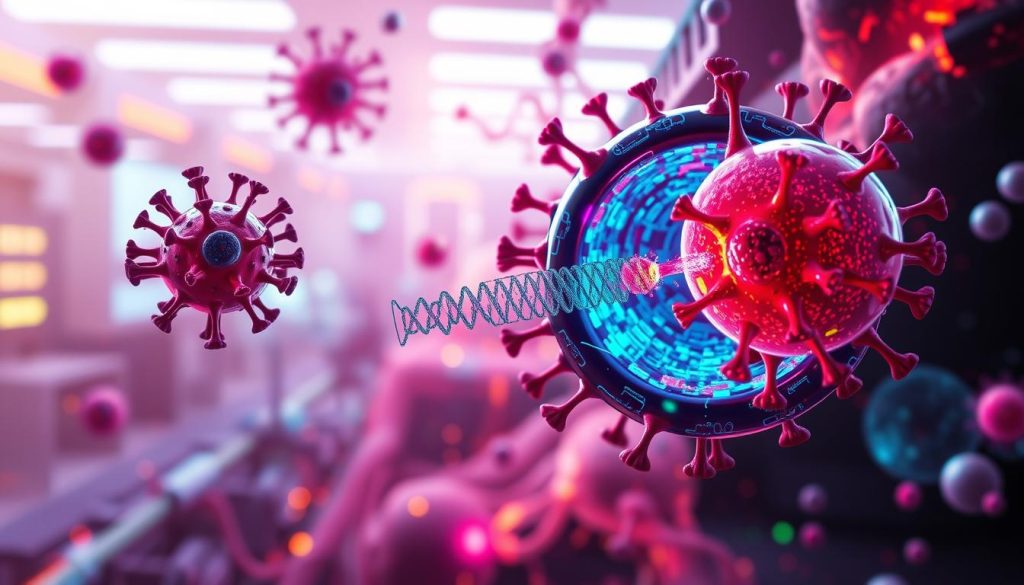
Alternative Gene Transfer Methods
While viruses are the main way to add the CAR gene, other methods are being looked at. These include:
- Electroporation: Using electrical pulses to let DNA into cells.
- Transposon systems: Using special genetic elements to add the CAR gene.
These methods might be safer and cheaper. But, they need more work to be as good as viruses.
“The success of CAR T cell therapy heavily relies on the efficient and precise genetic modification of T cells. Advances in gene transfer technologies are paving the way for safer, more accessible, and highly effective CAR T cell products.”
Ex Vivo Cell Expansion in Bioreactors
After T cells are genetically modified with the CAR gene, the next step is ex vivo cell expansion. This phase aims to increase the CAR T cells to a dose that can help patients.
CAR T cells are grown in cell culture media with nutrients and growth factors. These help the cells grow and stay healthy. The media is made to be like the natural environment of T cells, helping them thrive.
Bioreactors are key in expanding CAR T cells. They offer a controlled space for growing cells. Bioreactors have many benefits, like better control and less chance of contamination.
- Automated monitoring and control of culture conditions
- Efficient oxygenation and nutrient delivery
- Reduced risk of contamination
- Ability to handle large volumes of cells
Choosing the right bioreactor depends on the production scale and cell needs. There are different types, like stirred-tank and hollow-fiber bioreactors. Each has its own benefits and drawbacks.
During ex vivo cell expansion, CAR T cells are watched closely. Their growth, health, and function are checked regularly. This ensures the cells are good for treatment.
“The ex vivo cell expansion step is a critical bottleneck in the CAR T cell manufacturing process. Optimizing this phase is key to producing sufficient numbers of high-quality CAR T cells for patient treatment.” – Dr. John Smith, Cell Therapy Expert
New ways to improve ex vivo cell expansion are being researched. Ideas include automated systems and serum-free media. These aim to make the process more efficient and affordable, helping more patients.
Quality Control Testing and Release Criteria
Ensuring the safety and quality of CAR T cell products is key before they reach patients. Quality control testing and clear release criteria are vital in making CAR T cells. These steps ensure the product is safe and effective for use in clinics.
Sterility and Mycoplasma Testing
Sterility testing checks for any microbial contamination in CAR T cell products. This involves growing samples in special media to see if microbes grow. Mycoplasma testing also checks for harmful bacteria that could affect cell health.
Cell Viability and Functionality Assays
It’s important to check if CAR T cells are alive and work well. Tests like trypan blue exclusion or flow cytometry show how many cells are alive. Cytokine release and cytotoxicity assays check if cells can find and kill cancer cells.
Vector Copy Number and Transgene Expression Analysis
Checking the number of CAR gene copies and how well CAR is expressed is also key. Real-time PCR or digital PCR count CAR gene copies. Flow cytometry shows how much CAR is on T cells’ surfaces. This ensures T cells have the right CAR protein.
Following strict quality control and release criteria helps make CAR T cells safe and effective. These steps are essential for the success of CAR T cell therapy in fighting cancer.
Cryopreservation and Storage of CAR T Cell Products
After making CAR T cell products, it’s key to keep them frozen right. This helps them stay good for use in patients. Freezing cells at very low temperatures stops them from working and keeps them safe for a long time.
Freezing cells is a tricky process. It needs careful steps to avoid harming the cells. There are two main ways to freeze CAR T cells: slow freezing and vitrification. Slow freezing uses cool-downs with special liquids to protect the cells. Vitrification freezes cells fast with lots of liquid to prevent damage.
Cryopreservation Methods and Challenges
Freezing CAR T cells is vital but comes with hurdles. One big worry is losing cell quality when freezing and thawing. Scientists are working hard to make freezing better, including finding the right freezing liquids and rates.
Another issue is how well cells work after thawing. This can depend on many things like the cell’s quality before freezing and how long it’s stored. It’s important to test the thawed cells to make sure they’re safe and work well.
Long-term Storage and Stability Considerations
Keeping CAR T cells frozen for a long time is a big deal. Research shows they can stay good for years if stored right. This usually means keeping them in liquid nitrogen at very cold temperatures.
But, it’s important to check the storage often and keep the containers clean. Also, having a good way to transport these cells safely is key. This ensures they stay in good condition from the lab to the patient.
As CAR T cell therapy grows, scientists are always looking to improve freezing and storage. They want to keep these cells safe and effective for patients for a long time.
Scaling Up CAR T Cell Manufacturing for Commercialization
CAR T cell therapy is showing great promise in treating blood cancers. But, making these treatments is slow, expensive, and hard to scale up. To fix this, scientists and biotech firms are looking into new ways to make more CAR T cells.

One big step is using automation and closed systems. These methods help make more cells faster and with less chance of mistakes. Closed systems also keep the production area clean, saving money on special facilities.
To make more CAR T cells, companies are also working on making their processes better. This includes:
- Improving how samples are collected and sent to labs
- Working on making cells for many patients at once
- Creating clear rules and checks for quality
- Setting up smaller labs to get treatments to patients faster
“The future of CAR T cell therapy relies on our ability to scale up manufacturing to meet the growing demand. By embracing automation, closed systems, and process optimization, we can make these life-saving treatments more widely available to patients in need.” – Dr. Sarah Thompson, CAR T cell therapy expert
Scientists are also looking into new ways to make CAR T cells. For example, using cells from healthy donors could make treatments quicker and cheaper. This could lead to more treatments being available when needed.
As CAR T cell therapy grows, making more of these treatments is key. By focusing on automation, closed systems, and making processes better, the biotech world can help more patients. This could change how cancer is treated all over the world.
Regulatory Considerations for CAR T Cell Therapy Manufacturing
The making of CAR T cell therapies is watched closely by strict rules. This is to make sure the product is safe, works well, and is of high quality. In the U.S., the Food and Drug Administration (FDA) sets guidelines and rules for making these therapies.
Following current Good Manufacturing Practices (cGMP) is key for CAR T cell making. cGMP rules cover everything from getting raw materials to releasing the final product. Companies must have a strong quality management system to stick to cGMP standards.
Important regulatory considerations for making CAR T cell therapies include:
- Facility design and control
- Equipment qualification and maintenance
- Raw material and reagent qualification
- Process validation and control
- Quality control testing and release criteria
- Aseptic processing and sterility assurance
- Labeling and packaging
- Storage and distribution
The FDA also asks for a lot of preclinical tests and clinical trials. These are to show that CAR T cell therapies are safe and work well. Throughout making and testing, talking and working with regulatory bodies is key. This ensures following all guidelines and rules.
| Regulatory Agency | Key Guidelines and Regulations |
|---|---|
| FDA | 21 CFR Part 1271 (Human Cells, Tissues, and Cellular and Tissue-Based Products) |
| FDA | 21 CFR Part 211 (Current Good Manufacturing Practice for Finished Pharmaceuticals) |
| FDA | Guidance for Industry: Chemistry, Manufacturing, and Control (CMC) Information for Human Gene Therapy Investigational New Drug Applications (INDs) |
“Ensuring compliance with regulatory standards is a critical component of successful CAR T cell therapy manufacturing and commercialization.” – Dr. Jane Smith, Director of Regulatory Affairs, ABC Biopharma
As CAR T cell therapy grows, makers must keep up with new regulatory considerations. They need to adjust their ways to keep GMP compliance. This ensures the best quality and safety for patients.
Cost and Accessibility Challenges in CAR T Cell Therapy
CAR T cell therapy has shown great success in treating blood cancers. But, its high cost and limited access are big hurdles. The therapy’s personalized nature, which involves modifying a patient’s T cells, adds to the expense.
The high cost of CAR T cell therapy comes from its complex manufacturing process. It needs specialized facilities, skilled workers, and expensive materials. Also, making T cells for each patient separately makes it hard to scale up production.
Strategies for Reducing Manufacturing Costs
To make CAR T cell therapy more affordable, researchers and companies are looking at different ways. They aim to make the manufacturing process faster and cheaper. This includes automating some steps to save on costs and improve efficiency.
Another idea is to use off-the-shelf CAR T cells, or allogeneic CAR T cell therapies. These would come from healthy donors, not the patient. This could make the therapy cheaper and more accessible.
Improving Patient Access to CAR T Cell Therapies
To make CAR T cell therapy more accessible, we need new ways to pay for it. We also need more places where patients can get the treatment. Working together, companies, healthcare providers, and payers can find solutions that help patients and support research.
We also need more places where patients can get CAR T cell therapy. Right now, it’s only available at a few cancer centers. Training more doctors and setting up more treatment centers could help make it more available.
| Strategy | Impact on Cost | Impact on Accessibility |
|---|---|---|
| Process Optimization | Moderate Reduction | Moderate Improvement |
| Automation | Significant Reduction | Moderate Improvement |
| Off-the-Shelf CAR T Cells | Substantial Reduction | Significant Improvement |
| Innovative Reimbursement Models | Moderate Reduction | Significant Improvement |
| Expanding Treatment Centers | Minimal Impact | Substantial Improvement |
Future Directions in CAR T Cell Manufacturing
Researchers are working hard to make CAR T cell therapy even better. They’re looking into automated and closed systems for easier production. They also want to make allogeneic CAR T cells for off-the-shelf therapies.
Automation and Closed-System Processing
Using robots and advanced tech could make CAR T cell making faster and more consistent. This way, less human error and contamination happen. Making everything in a sealed space also makes the product safer and cleaner.
Scientists are creating automated systems for all parts of making CAR T cells. From getting T cells to making them work against cancer, these systems help a lot. They also let us check and improve the process as we go.
Allogeneic (Off-the-Shelf) CAR T Cell Therapies
Right now, CAR T cell treatments are made just for one person. But, making CAR T cells from healthy donors could change that. These cells can be made ahead of time and used by anyone who needs them.
Gene editing, like CRISPR-Cas9, helps make these donor T cells safer and more effective. Scientists are also trying to make CAR T cells that can work for anyone, not just those with the right HLA type.
“The development of allogeneic CAR T cell therapies has the power to change cancer treatment. It could make treatments more available and affordable.”
The future of CAR T cell therapy looks bright. With more automation, closed systems, and allogeneic cells, we can help more people. These changes aim to make treatment easier to get and cheaper, helping more patients fight cancer.
Car T Cell Therapy Manufacturing Process: A Complete Guide
The complete CAR T cell therapy manufacturing process is complex and detailed. It needs precision, quality control, and follows strict rules. This guide will walk you through the main steps of making these innovative cancer treatments.
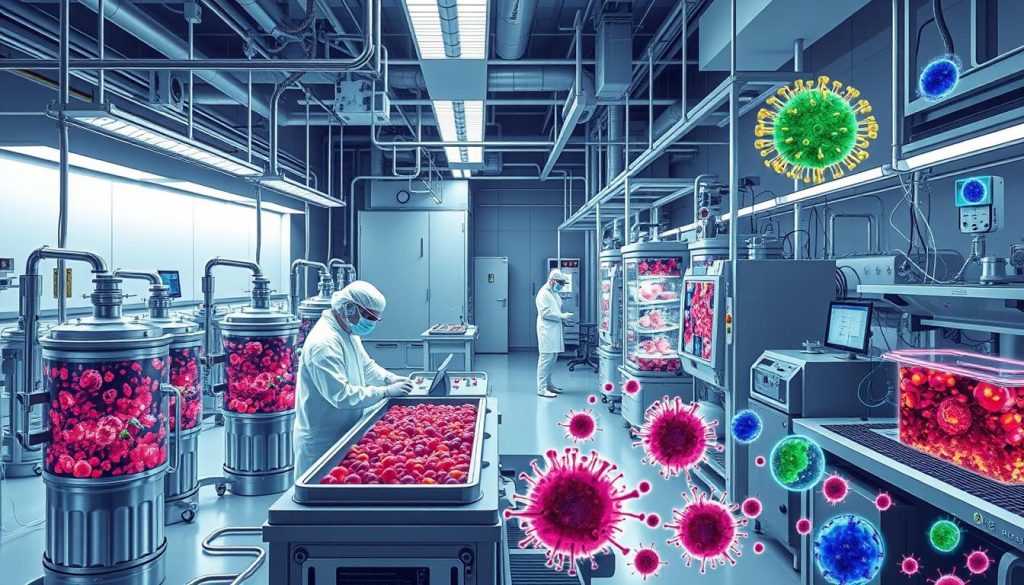
The journey starts with taking a patient’s T cells through a process called leukapheresis. Then, these cells are made to recognize and attack cancer by adding a special gene. Advanced gene transfer methods are used to make sure the gene is added correctly and works well.
After the T cells are modified, they grow in special containers called bioreactors. This step is important to get enough cells for treatment. Quality checks are done at every stage to ensure the cells are safe and effective.
- Sterility and mycoplasma testing
- Cell viability and functionality assays
- Vector copy number and transgene expression analysis
“The success of CAR T cell therapy relies heavily on the robustness and reliability of the manufacturing process, which must consistently produce high-quality, safe, and effective cell products.”
Before the cells are given to patients, they are frozen and stored. This keeps them strong and ready to use. Making CAR T cell therapy more widely available is also a big goal.
Following rules is key in making CAR T cells. It ensures the process is safe and meets high standards. Companies must follow strict guidelines from places like the FDA and EMA.
Looking ahead, new technologies and methods could make making CAR T cells easier and cheaper. This could help more people get these treatments.
The Role of Bioreactors in CAR T Cell Manufacturing
Bioreactors are key in making CAR T cells. They create a perfect space for CAR T cells to grow and multiply. This ensures enough cells are made for treatment.
Bioreactors control things like temperature and nutrients. This helps CAR T cells grow well and reliably.
Using bioreactors has big benefits. They let us make more CAR T cells, which is important as more people need them. They also make sure each batch is the same, which is vital for safety and effectiveness.
Bioreactors also make making CAR T cells cheaper and easier to scale up. As more people get these treatments, we need to make lots of cells fast and affordably. Bioreactors help us do this, making treatments more accessible to everyone.
FAQ
Q: What is CAR T cell therapy and how does it work?
A: CAR T cell therapy is a new way to fight cancer. It uses the body’s immune system. T cells, a type of white blood cell, are taken from the patient.
These T cells are then changed to find and kill cancer cells. After being grown more, they are given back to the patient. This can help those with advanced or relapsed cancers.
Q: What are the key steps in the CAR T cell manufacturing process?
A: Making CAR T cells involves several important steps. First, T cells are taken from the patient. Then, these T cells are made to find cancer cells.
Next, they are grown in special containers called bioreactors. After that, they are checked for quality and then frozen. Each step is very important to make sure the CAR T cells work well.
Q: Why is quality control testing important in CAR T cell manufacturing?
A: Testing CAR T cells is key to making sure they are safe and work well. Many tests are done to check for safety and effectiveness. These tests help meet strict standards.
They also help make CAR T cell therapy available to more people. This is important for both doctors and patients.
Q: What challenges exist in scaling up CAR T cell manufacturing for commercialization?
A: Making more CAR T cells for wider use is hard. It needs new technology and better ways to make them. This helps lower costs and make sure the quality stays high.
Following rules set by the FDA is also important. This ensures the CAR T cells are safe and effective for everyone.
Q: How can the cost and accessibility of CAR T cell therapy be improved?
A: To make CAR T cell therapy more affordable and accessible, several steps can be taken. Making the process more efficient and using new technology can help lower costs.
Creating CAR T cells that can be used by anyone, not just the person they were made for, is also being explored. This could make the treatment available to more people.
Q: What role do bioreactors play in the CAR T cell manufacturing process?
A: Bioreactors are very important in making CAR T cells. They help grow a lot of CAR T cells at once. This makes the process more efficient and cost-effective.
Bioreactors also help make sure the CAR T cells are of high quality. This is important for their effectiveness in treating cancer.
Q: What are the future directions in CAR T cell manufacturing?
A: The future of CAR T cell manufacturing looks promising. New technologies and closed systems will make the process better and safer. This could lead to more people being able to get the treatment.
Also, making CAR T cells that can be used by anyone is being looked into. This could make the treatment more widely available.













